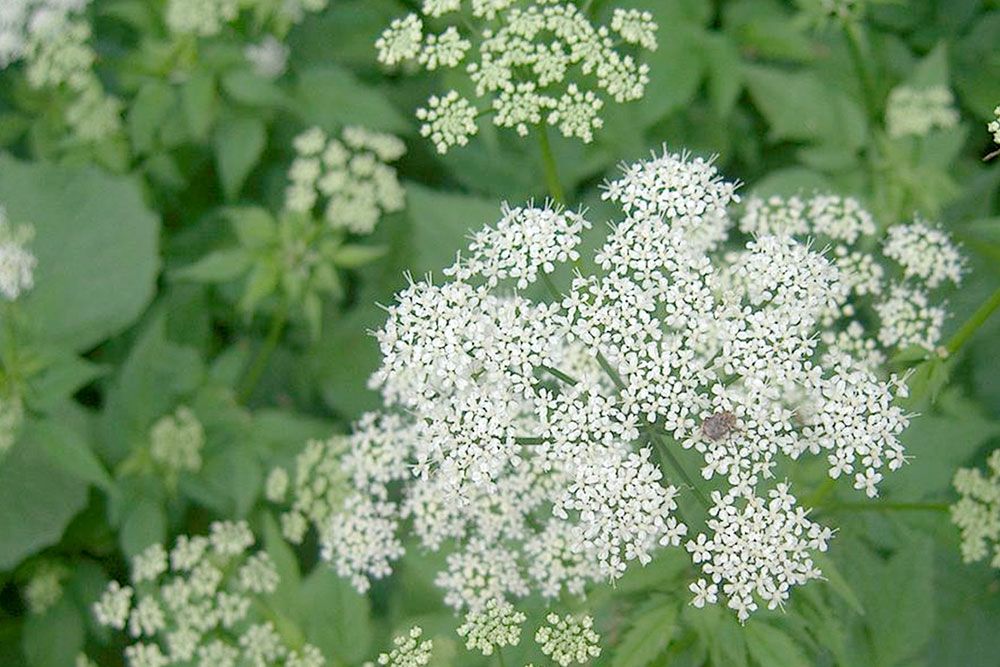Goutweed crowds out native plants

Invasive Plant of the Month Feature – Goutweed – Aegopodium podograria
Renee Sandelowsky and Helen Varekamp are Bayfield residents and local volunteers. They are writing a monthly series of articles, for the Canadian Coalition for Invasive Plant Regulation, about the benefits of planting native species of plants, removing invasive species, and finding alternatives to non-native plant species. This month (September 2025), their focus is the invasive plant Goutweed – Aegopodium podograria.
Invasive Goutweed is spreading rapidly on trails and in yards in Bayfield and area, crowding out native species of plants
By Renee Sandelowsky and Helen Varekamp
Look around Bayfield and beyond, and notice the Ivy, Lily of the Valley, and Periwinkle in the rights-of-way and yards. Notice the Goutweed on the trails. These invasive plants are spreading rapidly and crowding out native plants that serve a critical function in the ecosystem. As you begin to remove the invasive species in your own yard, you can replace them with native plants, and you will see an increase in biodiversity, especially pollinators.
Goutweed is a perennial, herbaceous plant, native to northern Asia and Europe. It was first introduced into America by European settlers during the mid-1800s. Two varieties exist: variegated and non-variegated. In some instances, variegated Goutweed can revert to the non-variegated type. It has been naturalized and locally abundant since the 1960s due to its appeal as an attractive garden ornamental. Aside from its aesthetic appeal, Goutweed’s popularity in gardening was mainly due to its low maintenance requirements, adaptability to various soil and light conditions, and its ability to grow and spread with little encouragement.
Today, Goutweed is regarded as one of the most problematic perennial garden species. Despite the harm it causes, it is not currently regulated under Ontario’s Invasive Species Act, and it is still commonly sold in some garden centres. Various other common names exist for Goutweed, including Ground Elder, Bishop’s Goutweed, Dog Elder, and Snow-on-the-Mountain.
Outside of its native range, Goutweed is a highly aggressive species capable of overrunning forests, displacing habitats, and reducing native biodiversity. Goutweed is a habitat generalist, meaning it can thrive in a wide variety of soil and light conditions and it is highly adaptable to many different environments. It is highly shade-tolerant and can even invade closed-canopy forests. It can take over fields, trails, tree lines, pastures, and disturbed sites where it produces leaves earlier than many native species, giving it an advantage. Goutweed can also reduce the survival rate of native tree and shrub seedlings by increasing the humidity and reducing sunlight penetration near the herbaceous layer of the forest floor. In addition, Goutweed’s flowers attract pollinators, altering native plant-pollinator interactions, and possibly decreasing the pollination of native species.
Goutweed is an extremely resilient plant, and once established, it can take multiple years to effectively eradicate the plant from an area because it spreads rapidly through a network of rhizomes, allowing it to extend up to 70 centimetres per year from its parent plant. The rhizomes easily break, giving rise to new plants from the fragmented pieces. These fragments can survive in the soil for over four years. Avoid planting and sharing of Goutweed and look for native species of plants as alternatives.
HOW TO MANAGE GOUTWEED
Managing Goutweed is challenging but achievable with persistence and a multi-step approach:
- Manual Removal: Removal is most effective when the soil is moist. Small areas can be dug out by using a shovel, ensuring all parts of the rhizome roots are removed. Pieces of root left behind can promote reproduction and worsen the spread. Do not put plants in the compost or municipal green waste. Put them in the garbage instead.
- Smothering: Tarping is another method to effectively prevent goutweed photosynthesis. Tarping is the most practical during the early spring, and can be done with any solid material such as black plastic tarps, sheeting or cardboard. Cutting Goutweed back to ground level before smothering is most effective and should be done before flowering.
- Herbicide Treatment: Alternately, larger areas can be eradicated by a herbicide application. Use herbicides only as a last resort, following all applicable regulations to minimize environmental harm.
After removal, replant the area with regionally appropriate native plants. This step is essential to prevent reinfestation and to restore ecosystem health. Native plants will also attract pollinators and wildlife, improving biodiversity in your garden.
A good choice to plant, as an alternative, would be Wild Ginger – Asarum canadense or Golden Alexander – Zizia aurea.
LEARN MORE AND TAKE ACTION
Education is key to combatting invasive plants. Learn to identify invasive species and choose native or non-invasive alternatives for your garden. Focus on managing one or two invasive plants at a time and be patient—successful eradication takes time and persistence.
To learn more, visit:
- Ontario Invasive Plant Council
- Canadian Coalition for Invasive Plant Regulation
- Grow Me Instead Guide